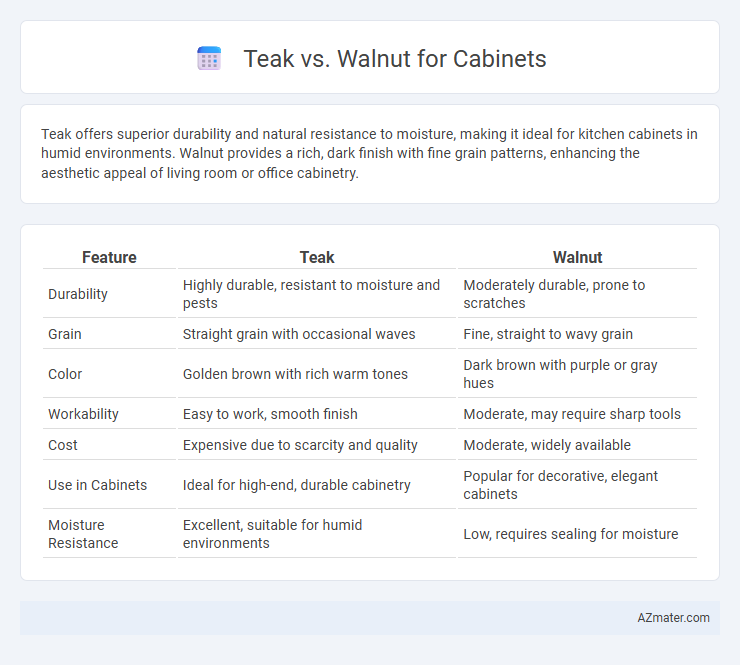Teak offers superior durability and natural resistance to moisture, making it ideal for kitchen cabinets in humid environments. Walnut provides a rich, dark finish with fine grain patterns, enhancing the aesthetic appeal of living room or office cabinetry.
Table of Comparison
| Feature | Teak | Walnut |
|---|---|---|
| Durability | Highly durable, resistant to moisture and pests | Moderately durable, prone to scratches |
| Grain | Straight grain with occasional waves | Fine, straight to wavy grain |
| Color | Golden brown with rich warm tones | Dark brown with purple or gray hues |
| Workability | Easy to work, smooth finish | Moderate, may require sharp tools |
| Cost | Expensive due to scarcity and quality | Moderate, widely available |
| Use in Cabinets | Ideal for high-end, durable cabinetry | Popular for decorative, elegant cabinets |
| Moisture Resistance | Excellent, suitable for humid environments | Low, requires sealing for moisture |
Teak vs Walnut Cabinets: An Introduction
Teak cabinets are prized for their exceptional durability, natural resistance to moisture, and rich golden-brown hues, making them ideal for kitchens prone to humidity. Walnut cabinets are celebrated for their deep, dark tones and intricate grain patterns, adding a sophisticated and elegant appeal to interior spaces. Both woods offer distinct benefits, but teak's robustness often suits high-traffic environments, while walnut provides a warm, luxurious finish ideal for formal settings.
Appearance and Grain Patterns
Teak cabinets showcase a rich golden-brown hue with distinctive straight grain patterns that often feature natural oils, enhancing durability and a smooth finish. Walnut offers a deeper, chocolate to dark brown color with striking, irregular grains and occasional swirls, providing a luxurious and dramatic visual appeal. Both woods bring unique textures and warmth, with teak displaying a more uniform grain and walnut highlighting complex, varied patterns for cabinet aesthetics.
Durability and Hardness Comparison
Teak offers exceptional durability and resistance to moisture, making it ideal for cabinets in humid environments, with a Janka hardness rating of approximately 1,070 psi. Walnut, known for its rich color and smooth grain, has a slightly lower Janka hardness of around 1,010 psi but provides good durability for indoor cabinetry. Both woods are strong, yet teak's superior natural oils give it an edge in longevity and resistance to wear and decay.
Resistance to Moisture and Decay
Teak cabinets exhibit superior resistance to moisture and decay due to natural oils and silica content, making them ideal for humid environments or kitchens. Walnut offers moderate moisture resistance but requires proper sealing to prevent water damage and decay over time. Choosing teak ensures long-lasting durability against moisture-related wear compared to walnut in cabinetry applications.
Maintenance and Care Requirements
Teak cabinets require minimal maintenance due to their natural oils that resist moisture and pests, making them ideal for humid environments. Walnut cabinets demand regular conditioning with oil or wax to maintain their rich color and prevent drying or cracking over time. Proper care extends the longevity of both woods, but teak generally offers greater durability with less frequent upkeep needed.
Cost and Value Analysis
Teak cabinets typically command higher initial costs due to the wood's natural oils, durability, and resistance to moisture, making it ideal for long-term value and outdoor use. Walnut offers a rich, dark aesthetic at a relatively lower price point, appealing to buyers focused on luxury appearance within a moderate budget. Evaluating cost against lifecycle value, teak provides superior longevity and minimal maintenance expenses, while walnut delivers excellent style and craftsmanship value but may require more upkeep.
Sustainability and Environmental Impact
Teak cabinets are prized for their natural resistance to pests and moisture, reducing the need for chemical treatments and promoting long-term durability, which contributes to sustainability. Walnut, often sourced from temperate forests with varied growth rates, requires careful forest management to ensure sustainable harvesting and minimize ecological disruption. Certification systems like FSC and PEFC play a crucial role in monitoring both teak and walnut supply chains to support environmentally responsible forestry and reduce carbon footprints in cabinet production.
Suitability for Modern and Traditional Cabinet Designs
Teak offers rich golden hues and natural oil content, making it highly durable and resistant to moisture, ideal for both modern sleek finishes and traditional warm cabinetry. Walnut's deep brown color and fine grain complement traditional cabinet designs with a classic, elegant appeal while also fitting contemporary styles through its smooth texture and strong durability. Both woods provide versatility in cabinet construction, but teak is particularly favored for high-moisture areas whereas walnut excels in adding timeless sophistication to varied design themes.
Pros and Cons of Teak Cabinets
Teak cabinets offer exceptional durability and natural resistance to moisture, insects, and decay, making them ideal for kitchens and bathrooms with high humidity. Their rich golden-brown hue enhances interior aesthetics but may darken over time due to exposure to sunlight. However, teak tends to be more expensive than walnut and can be prone to surface scratches, requiring regular maintenance to preserve its original luster.
Pros and Cons of Walnut Cabinets
Walnut cabinets offer rich, dark tones that enhance luxury kitchen designs, boasting natural durability and resistance to warping. Their fine grain provides a sleek finish ideal for modern or classic styles, but walnut is generally more expensive and can show scratches more easily than other woods. While walnut ages beautifully with a warm patina, it requires regular maintenance to preserve its appearance and avoid fading.

Infographic: Teak vs Walnut for Cabinet
 azmater.com
azmater.com